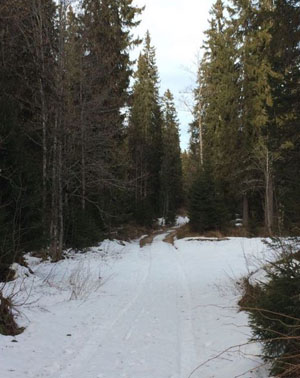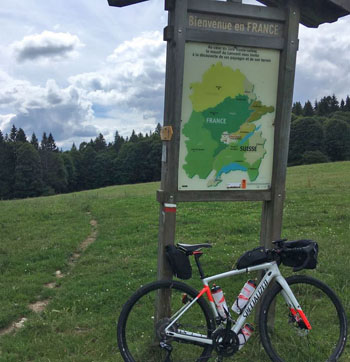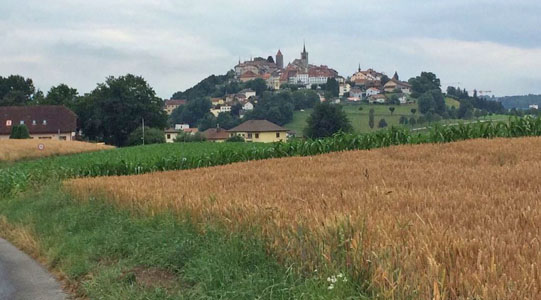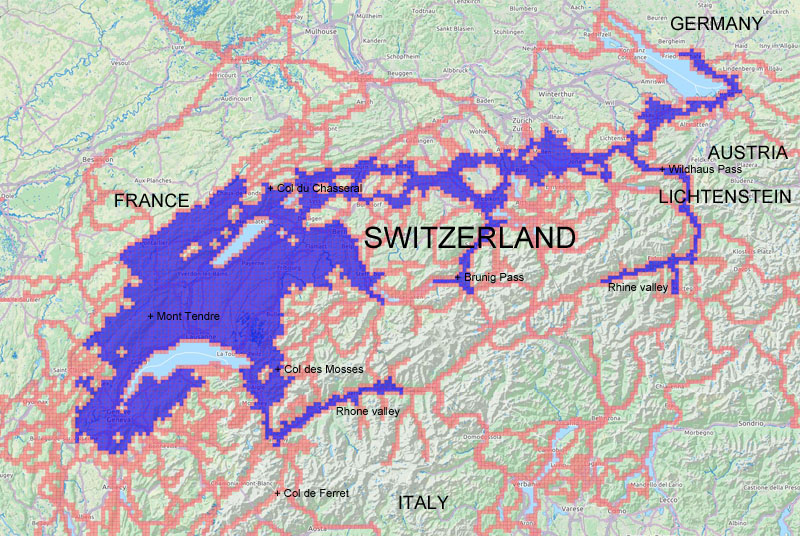Last December, I discovered the VeloViewer Explorer score, which measures how many tiles on the map of the world that you’ve ridden through. The size of each tile is about 1.7 x 1.7 km in my region (the size varies slightly based on the distance from the equator). VeloViewer is a website that takes your Strava ride data and generates a massive amount of new statistics and presents it in ways that are far superior to the simplistic approach of Strava.
Measuring Exploration
Ever since I started bike touring 20 years ago, I’ve kept a paper or digital record of where I’ve ridden and have always tried to ride new roads and explore different places by bike, but I never before had a metric to measure how well I was achieving this goal. The Explorer tiles and scores are therefore ideal for me and I find it highly motivating and it encourages me to explore every corner of my region.
This map shows the result of my tile-hunting exploits; click it to see a larger version. Tiles that I’ve passed through are highlighted in red. Tiles that are in my cluster are highlighted in blue (explained below). I’ve marked the locations of some places that I mention below.

I had already covered a decent amount of tiles before I learnt of the metric at the end of 2016 (see this blog post) and then quickly went out to pass through the closer tiles that I’d previously missed, which resulted in me riding 1500 km last December, a new winter record for me. I live in Switzerland, so a lot of the higher regions become inaccessible by bike in the winter, but I kept pushing the limits of where I could ride to get a few new tiles throughout the winter and spring. Since the summer hit, I’ve been in full-on tile-seeking mode and in the past three months I’ve ridden 6,000 km and climbed over 100,000 meters, both of which are new records for me (not including months in which I’ve done the Transcontinental Race).
There’s a Ride Every Tile group on Strava where like-minded people post about their obsession and leaderboards on VeloViewer that show where you stand. I’m proud that, out of all people who use VeloViewer, I’m in the top 10 for the total number of tiles covered (over 23,000, of which about half are shown in the map above, colored in red or blue) and the size of my largest continuous cluster of tiles (3,501 tiles, shown in blue on the map and explained below).
The maximum square score is based on the largest continuous, unbroken square region of tiles that you’ve covered. I struggle on this metric due to having Lake Geneva to the south and Lake Neuchatel to the north of where I live in Lausanne, Switzerland, and I’m not keen on doing water-sports when I could be cycling instead, so my max-square score has been stuck at 21×21 tiles since the winter (you currently need at least 30×30 to be in the top 20).

Exploring in Switzerland
Most of the other people who rank highly on the VeloViewer leaderboards are in the UK and Benelux; I’m by far the highest-placed person living in a mountainous region. The mountains make tile-seeking an intriguing 3D puzzle and although the climbing makes many tiles a lot harder to reach, I find that makes the achievement all the more rewarding and the views are certainly better. In addition, many of the roads in more mountainous regions tend to be quieter than those in flatter regions.
Despite the mountains and lakes sometimes getting in the way, I think Switzerland is actually pretty ideal for tile hunting because there are small roads going almost everywhere. When there is no road then there’s almost sure to be a hiking trail and, unlike certain other countries, bikes are allowed on virtually all trails. Taking a bike on the extensive Swiss train network is also very easy so I can start or end rides further from home; I don’t have a car so I get everywhere by bike or train.

My Specialized Diverge
I’m very pleased with my new Specialized Diverge gravel bike because it’s an excellent tile-hunting machine. Despite handling light to moderate trails reasonably well and being exceptional on dirt/gravel roads, it’s still fast and efficient on the road. I’ve equipped it with super-low gearing so that I can get up almost any incline (currently 26/42 chainrings and an 11-32 cassette, see the page on Gear Ratios for Bikepacking & Ultra-Distance Cycling).
I have two sets of wheels for the bike, one with 40mm-wide tubeless tires with some tread that I use when I know there is going to be a lot of trails and unpaved roads and a second set with 28-32mm slick tires for excursions that I expect to be mostly on-road (although there is nearly always a bit of gravel somewhere). I have a mountain bike but I don’t really need it now that I have the Diverge with it’s minimal 20mm of suspension in the steering column, which improves comfort slightly but more importantly keeps the front wheel on the ground on the rough stuff, and I find 40mm tires to be sufficient on the stuff that I tend to ride.
Tile Cluster Score
After VeloViewer initally gave scores for the total number of tiles covered and the maximum continuous square region of tiles completed, the cluster score was introduced in June as a response to the fact that many people like me weren’t able to get all of the tiles needed to compete on the max-square metric. My cluster is shown in blue in the map above. For a tile to be in the cluster, you need to have ridden through it as well as the adjacent tile to the north, south, east and west; for the cluster to expand to an adjacent tile, that tile must also satisfy these criteria.
The requirements for the cluster mean that to extend it you need to ride through a band of tiles that measures at least three tiles north-south or east-west, so riding along a single road though a new region is not sufficient to extend your cluster. When heading diagonally across the map (southwest-northeast or southeast-nortwest), the band of tiles actually needs to be four tiles wide so that those in the cluster are adjacent; potential cluster tiles that only touch an existing cluster tile on the corner are not counted.

Extending the cluster into mountainous regions is therefore particularly difficult, often requiring me to ride repeatedly up and down each side of a valley, which is why I’m especially proud of the sections of my cluster up the Rhone and Rhine valleys, which required far more climbing than you might imagine.
Continuing the cluster from one valley to another is also challenging because it requires not only riding over the pass, but also reaching the tiles on each side of the pass and doing so all the way up the valleys on both sides. In the Alps, I’ve managed to link the Rhone and Saane valleys with my cluster going over Col des Mosses (at an elevation of 1445 meters), the Ruess and Aare valleys via the Brunig Pass (1008 meters), and the Linth/Limmat and Rhine valleys via the Ricken Pass (790 meters) to the Thur valley and then over the Wildhaus Pass (1027 meters). My cluster includes several higher Alpine passes that are not as geographically important, including the highest paved passes in the Vaudois Alps: Col de la Croix (1778 meters) and Col de Bretaye (1806 meters).
It’s easier to cover all of the tiles in the Jura mountains on the western edge of Switzerland than in the Alps becuase the Jura are generally lower and the valleys are less steep. My cluster includes almost all of the southern Swiss Jura including the highest point of the Swiss Jura (Mont Tendre at 1679 meters) and the highest paved pass in all of the Jura (Col du Chasseral at 1502 meters elevation).
UPDATE: My tile cluster has been featured in a post on the ExplorerSquare blog about Pretty Clusters.
Other Goals
Another goal for me is to cover all the tiles within each of the Swiss cantons (counties) near to where I live: I’ve already completed everything in Geneva (which is quite small), covered almost all of Vaud and Neuchatel plus most of Fribourg. Eventually, I’d love to cover the whole country, but that will take a LONG time and I’ll have to ignore some of the tiles in the highest Alps (tiles that are entirely above 2000 metres elevation are generally quite inaccessible).
I also enjoy spreading my cluster to other countries. I’ve already included five countries: Switzerland, France, Germany, Austria, and Lichtenstein, which are all marked on the map above (borders are shown by a faint white line that you can see if you clck the map to zoom in). I have plans for how to reach my sixth country by crossing the Alps into Italy near Col de Ferret, but since that is at an elevation of almost 2,500 meters it will require hiking to reach some tiles that are not so accessible on the bike.
The distance between one end of my cluster (near Bellegarde, France) and the other (Friedrichshafen, Germany) is about 500 km. The width and height of the region above Lake Geneva that is almost entirely covored with my blue cluster in the map above is about 70 km by 70 km, or 5,000 square kms.
Looking at the map, it’s obvious that there are a LOT of gaps in my cluster and places where I could easily extend it significantly. This makes choosing where to ride next one of the more difficult aspects of this new obsession. Summer is ending, so it won’t be long until the higher elevations will have snow on again so I’m trying to focus on the higher regions for now.

Conclusion
I’m motivated not only by coloring in the map tiles and the physical challenge that this entails, but also because by doing so I’ve found some amazing hidden corners of the country that I would have never otherwise visited. Indirect back roads through random villages and all of those dead-end roads and valleys that I’d previously ignored have suddenly become enticing. I’ve ridden past countless beautiful and interesting features and vistas and through charming towns and villages. Unfortunately, unless I’m with my wife or someone else then I’m often in a racing mindset and rarely stop to enjoy those places fully, instead choosing to press on and reach ever more tiles.
After I told my friend Jeff about the Explorer score, he became almost as obsessed as me about getting all of the tiles in his region around Lake Zurich. He varies his activities a lot more than I do, mixing up cycling with trail running in the hills and swimming and kayaking in the lakes to get every tile he can. His wife has thanked me for renewing his motivation to go ride with her.
I highly recommend signing up to VeloViewer, installing the Explorer extension for the Chrome browser and spending some time planning routes on new roads and trails so that you can tick off as many map tiles as possible and discover new places and have renewed motivation to Ride Far and often. If you want to see where these rides take me, then follow me on Strava. Have fun tile hunting!

Obsession is not a bad thing. Summer is not ending, it’s just coming back to the southern hemisphere. You should join it and come ride the Tour Aotearoa next year.
I like your website! Lot of useful information. I’m now at 20×20 square and also live in Switzerland. I hope to catch up soon to your 23×23 🙂
Dear Chris,
Thank you for this article, it helps me in my decision to sell my specialized Stumpjumper and my Canyon ultimate to purchase a diverge 2018.
Do you have it in stock in your Lausanne bike shop ?
Which you a nice ride !
Thanks again for sharing the tile-hunting game with us (especially Jeff)! It’s added a whole new energy to our biking, and the exploring of dead-end roads or valleys has led us to many incredibly beautiful “hidden” places we never would have known about otherwise. Looking forward to enjoying some more exploring with you in the new year (once it gets warmer! :-))
Thanks Becky. I’m pleased that you and Jeff are having fun with this, too. I’ll definitely be back to get some more tiles south of Lake Zurich soon.
I just found this nice blog post about the people with the 7 biggest clusters. Mine is being lauded as one of the prettiest, which I’m quite proud of: https://explorersquare.wordpress.com/2018/01/10/pretty-clusters/